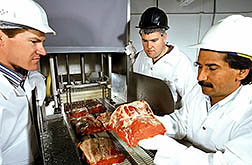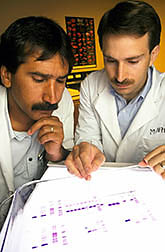Toward More Tender Beef
|
|
Shopping at a supermarket meat counter stocked with fine-textured, firm, bright-red steaks, you want to pick one that will cook up really tender. Your best guess is to take one that's well marbled with tiny flecks of fat.
For today's savvy shoppers, marbling is the only indicator of tenderness. But with tomorrow's technologies, less knowledgeable consumers may be more confident of choosing beef that is tender and tasty.
ARS researchers hope in the next 10 years to advance the science of breeding animals so that such meat is reliably classified and consistently available.
Because tenderness of beef is not highly predictable and is known for sure only when the meat is eaten, it has been identified as one of the hottest topics in the livestock and meat industry, says Dan Laster, director at the Roman L. Hruska U.S. Meat Animal Research Center (MARC) in Clay Center, Nebraska.
But marbling accounts for only about 10 percent of the variation in meat tenderness, says animal physiologist Mohammad Koohmaraie, head of the center's Meats Research Unit. From among many other positive and negative influences on tenderness, he and his colleagues have found an enzyme-inhibiting protein called calpastatin that accounts for another 44 percent of the variation in tenderness of aged beef.
Depending on cattle's genetic makeup, different levels of calpastatin exist in the meat and contribute to toughness by inhibiting an enzyme—calpain—in the postmortem aging, or tenderizing process.
"Beef tenderness or toughness, controlled about 70 percent by environment and 30 percent by heredity, may involve expression of many genes," says Koohmaraie.
Because each gene's contribution is minor compared to confounding environmental factors, identifying desired gene combinations would be almost impossible through classical inheritance studies—like "looking for a needle in a haystack." But ferreting out the genetics is just the kind of task that may be doable, with refinement of the world's first cattle genome map that was recently published by a 12-member MARC research team.
Scientists of the gene mapping group and the Meats Research Unit have found various forms of a gene for calpastatin on chromosome 7 of the beef genome and have developed diagnostic probes for them. The idea is to use such probes--DNA fragments that bind to a specific form of genetic material—to tell whether an undesirable gene is possessed by an individual animal, group, or family of animals. Researchers may know within 3 years how well calpastatin probes will work in the quest for tender beef.
But defining future strategies to produce beef of the best eating quality will involve much more than detecting calpastatin genes, Koohmaraie says. Just as tenderness is not the only influence on palatability, calpastatin is not the only factor affecting tenderness. However, calpastatin explains more of the variation in tenderness than does any other trait.
A project is now under way at MARC to identify chromosomal regions that are associated with differences in beef tenderness. Successful completion of this project will allow selection for tender beef prior to slaughter.
Someday, calpastatin in beef may be measured routinely as part of a quality classification system that would lend itself to marketing of branded products of predictable quality. Koohmaraie and his colleagues are trying to develop such a measurement test.
The classification system may even evolve to include tests on live cattle before marketing. Carcasses from cattle rated unacceptably tough in calpastatin-based or marker-assisted tenderness scores might be targeted for special treatment such as calcium-activated tenderization.
The technologies may help those cattle breeders who are faced with about the same degree of genetic variation within breeds as between breeds for many traits, says Larry V. Cundiff, a MARC animal geneticist.
Cattle of mostly Bos indicus breed ancestry—valued for their heat tolerance, reproductive abilities, and the hybrid vigor they contribute to crossbreeding programs—are more likely than their Bos taurus counterparts to produce tough beef. "When we can identify desirable genes in individual animals, we can more freely use breeds for the traits they bring to a crossbreeding system," Cundiff says.
In a study of meat from 555 steers—mostly crossbreds but including 9 purebred lines—ARS food technologist Steven D. Shackelford and his colleagues at MARC concluded that breeding for low levels of calpastatin may be one of the routes to tender beef.
They studied heritabilities of traits and also took into account the associations—statistical correlations—between calpastatin activity and intramuscular fat, tenderness, retail product yield, and average daily weight gain.
Generally, animals with desirably low levels of calpastatin yielded more lean meat per pound of carcass than did animals with desirably high levels of marbling.
If genetic markers prove to be an indicator of beef tenderness and palatability, says Laster, marbling may come to be regarded as a less important factor in predicting eating quality. So, many cattle in the future may not be fed as long on large amounts of the grain and concentrated feed supplements required to meet today's quality grade standards.
An extra pound of gain—largely fat—on a 1,200-pound animal often requires about 40 percent more feed—mostly grain—than a pound of gain on a leaner 1,100-pound animal. And much excess fat at the edge of heavily marbled cuts is routinely trimmed away.
That means that when consumers can be reliably assured that beef is tender, though not heavily marbled, the beef industry will be able to provide a leaner product at less cost.
Calcium-Activated Tenderization
In addition to the calpastatin work, Koohmaraie and his colleagues have also found that injecting a controlled amount of calcium chloride solution into meat anytime after slaughter enhances meat tenderness.
The current protocol for Calcium-Activated Tenderization (CAT) calls for injecting cuts of meat with up to 5 percent, by weight, of a 2.2 percent food-grade calcium chloride solution and then vacuum packaging and storing them for 7 days before consumption.
Calpain enzymes, activated by the calcium chloride solution, tenderize tough beef by breaking apart a ropelike protein called desmin that holds strands of muscle fiber together.
"The calpains degrade themselves at the same time they degrade muscle proteins," says Koohmaraie.
The process is effective in all muscle at any time after slaughter, regardless of livestock species, breed, or gender. And the injected calcium chloride activates the calpains without overtenderizing the meat.
Calcium chloride injection, which is similar to the process used for many years by the meat industry to inject water and curing ingredients into hams, has received federal regulatory approval. But appropriate labeling of the meat products is required before a company can sell them.
Besides improving tenderness, the calcium chloride solution gives beef a calcium content about half that of milk, with no adverse effect on the meat's color or shelf life, Koohmaraie says. And according to MARC food technologist Tommy L. Wheeler, consumer tests indicate both restaurant and supermarket consumers prefer calcium-injected beef because of its improved tenderness. — By Ben Hardin, ARS.
Scientists mentioned in this article are at the Roman L. Hruska U.S. Meat Animal Research Center, P.O. Box 166, State Spur 18D, Clay Center. NE 68933; phone (402) 762-4109.
"Toward More Tender Beef" was published in the March 1995 issue of Agricultural Research magazine.








